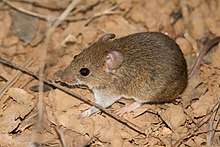Hairy-tailed bolo mouse
The hairy-tailed bolo mouse or hairy-tailed akodont (Necromys lasiurus) is a South American rodent species of the family Cricetidae.[2] It is found in Argentina, Bolivia, Brazil and Paraguay.
| Hairy-tailed bolo mouse | |
|---|---|
 | |
| Scientific classification | |
| Kingdom: | Animalia |
| Phylum: | Chordata |
| Class: | Mammalia |
| Order: | Rodentia |
| Family: | Cricetidae |
| Subfamily: | Sigmodontinae |
| Genus: | Necromys |
| Species: | N. lasiurus |
| Binomial name | |
| Necromys lasiurus (Lund, 1841) | |
Description
The hairy-tailed bolo mouse grows to a head-and-body length of between 118 and 138 mm (4.6 and 5.4 in), with a tail length of 66 and 96 mm (2.6 and 3.8 in). The ears are small and rounded and have a sparse covering of hair. The body fur is variable in colour but usually the back is olive grey to dark brown, the flanks are paler and washed with ochre, and the underparts are white or pale grey. The demarcation line between upper parts and underparts is ill-defined. The tail is bicolor, dark above and pale below, and clad in short, fairly dense fur, and the feet are brown on top with tufts of white hair between the digits, which have strong nails.[3]
Distribution and habitat
The hairy-tailed bolo mouse is native to southern South America. Its range extends from eastern and central Brazil as far west as Rondônia, through eastern Paraguay to northeastern Argentina. The exact boundaries are not well known, with various isolated outlying areas and with populations west of the Paraguay River overlapping the range of the Paraguayan bolo mouse (Necromys lenguarum). Its typical habitat is grassland, the verges of cultivated fields and areas of secondary woodland.[3]
Ecology
The hairy-tailed bolo mouse is mainly diurnal, with some activity at dusk and at night, particularly in the dry season. Its diet varies with the time of year but mainly consists of seeds and green plant material, and sometimes includes small invertebrates. The breeding season is mostly in the spring and summer and litter sizes average about five young. This mouse is a reservoir for certain hantaviruses, including the Araraquara strain from Brazil which can cause disease in humans.[3] The Hairy-tailed bolo mouse is a host of the Acanthocephalan intestinal parasite Moniliformis necromysi.[4]
References
- Marinhio-Filho, J.; Vieira, E.; D'Elia, G.; Pardinas, U. (2008). "Necromys lasiurus". IUCN Red List of Threatened Species. 2008: e.T2859A9488040. doi:10.2305/IUCN.UK.2008.RLTS.T2859A9488040.en.
- Musser, G.G.; Carleton, M.D. (2005). "Superfamily Muroidea". In Wilson, D.E.; Reeder, D.M (eds.). Mammal Species of the World: A Taxonomic and Geographic Reference (3rd ed.). Johns Hopkins University Press. p. 1130. ISBN 978-0-8018-8221-0. OCLC 62265494.
- Patton, James L. (2015). Mammals of South America, Volume 2: Rodents. University of Chicago Press. pp. 238–241. ISBN 978-0-226-16957-6.
- Gomes, A.P.N.; Costa, N.A.; Gentile, R.; Vilela, R.V.; Maldonado, A. (2020). "Morphological and genetic description of Moniliformis necromysi sp. n. (Archiacanthocephala) from the wild rodent Necromys lasiurus (Cricetidae: Sigmondontinae) in Brazil". Journal of Helminthology. 94: e138. doi:10.1017/S0022149X20000188. PMID 32188515.
